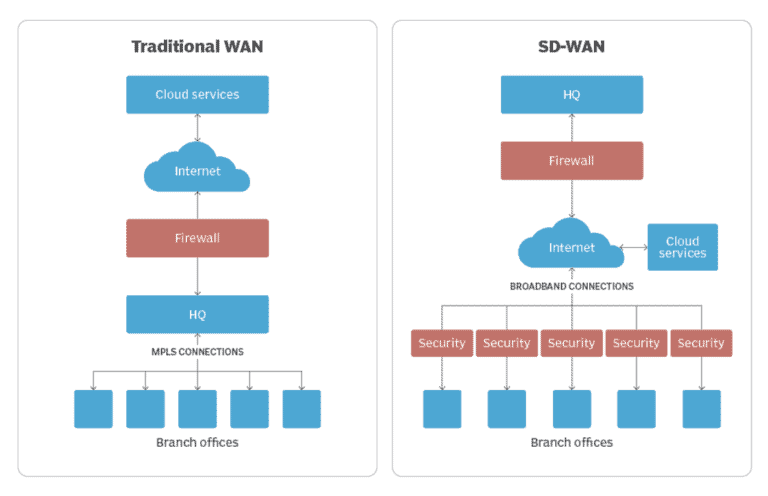What is SD-WAN?

SD-WAN is the use of software to manage devices and lines to achieve the benefits of WAN routing, security, and reduce network service and operational costs… To find out what SD-WAN is, let's learn from the basics first:
What is WAN?
A wide area network (WAN) is a mainframe network that connects groups of computers over large distances.
WANs are often used by large enterprises to connect global office networks; Each office usually has its own local area network or LAN, and these LANs connect via WAN.
These long connections can be formed in a variety of ways, including leased lines, VPN via Internet.
The definition of what constitutes a WAN is quite broad. Technically, any large network that spans a wide geographical area is a WAN. The Internet itself is considered a WAN.

What is SD-WAN?
SD stands for Software-Defined ie using software to manage devices and transmission lines to achieve the following benefits:
+ Make network changes faster than updating WAN routers.
+ Improve security.
+ Improve network availability and reliability
+ Improve the agility of the IT system.
+ Access cloud services more directly and efficiently.
+ Improve cloud application performance
+ Reduce network service costs and human resources
Basically, SD-WAN supports 02 following advantages:
1. Allow network connection: Use all WAN connections simultaneously – broadband public internet, DIA, ethernet, private MPLS line, etc. – while intelligently manipulating traffic to optimize application performance.
2. Allow IT “agile” more than everGive customers the performance guarantee to add connections and use applications quickly and with less downtime.

Traditional WAN vs SD-WAN


If compared with traditional WAN models, the WAN infrastructure control function is distributed evenly across all network devices. Routers now only route network traffic based on TCP/IP addresses and Access Control List.
Without SD-WAN, connecting branch offices to cloud applications is expensive. Traditional LANs have to "backhaul" traffic to corporate headquarters or data centers, usually on MPLS. This can lead to a poor user experience. SD-WAN provides efficient access to cloud-based resources, which leads to better user collaboration, less frustration, and a better overall user experience.
More clarification on SD-WAN
1. SD-WAN IS A DEVICE-BASED SOLUTION
SD-WAN is a physical or virtualized hardware appliance solution that enables customers to utilize any type of bandwidth – private or public. Many people mistakenly believe that “SD-WAN is only used when you have Internet service”, but this is wrong.
2. SD-WAN CAN USE ANY INTERNET LINE SERVICE AVAILABLE
When implementing SD-WAN, IP packets are intelligently routed to SD-WAN devices at end-to-end encrypted endpoints across the entire WAN.
Since SD-WAN is not tied to a specific service provider, endpoints can take advantage of any type of bandwidth – meaning you can use a private MPLS service or Internet Leased Line, 4G LTE or even more cost-effective public Broadband Internet

3. SD-WAN USING CENTRALIZED CONTROLLER
SD-WAN can connect with each other thanks to the centralized controller (Orchestrator). Using a rule-based policy system, bandwidth resources are assigned automatically based on a prioritized list of applications, users, and locations.
SD-WAN continuously monitors bandwidth usage, packet loss, and latency, and automatically selects the best path according to whatever parameters you choose. By continuously monitoring and throttling, SD-WAN ensures that you always get the best possible application performance.

The future of SD-WAN
It is undeniable that the use and technology of SD-WAN has contributed to improving business networks in the era of digital transformation as well as applying cloud computing to business.
With more than 24 years of experience in consulting, implementing and trading telecommunications and network-related information technology solutions, FPT Telecom can confirm that the upcoming trend of SD-WAN is the close combination of closely with Cloud Computing, typically there will be the following 03 predictions:
+ Prediction 1: MORE POPULAR APPLICATIONS DEVELOPING ON CLOUD. THE DEMAND FOR THE USE OF MULTI-CLOUD INCREASES THE APPLICATION OF SD-WAN INTO MULTI-CLOUD NETWORKING SYSTEMS.
>> Not depending on any provider leads enterprises to deploy their applications on different cloud service providers (CSPs) such as AWS, Azure, GCP... Therefore, the need for The need to deploy a software-based network infrastructure that is flexible, quick to deploy, zero-touch, secure, and guaranteed in terms of reducing data transmission costs will be at the forefront.
+ Prediction 2: TRACKING AND MANAGEMENT BECOMES EASIER. SAVE A LOT OF SYSTEM OPERATION RESOURCES
+ Prediction 3: IMPROVE APPLICATION PERFORMANCE ON CLOUD THROUGH WAN-OPTIMIZATION. SAVE BANDWIDTH COSTS
>> The use of public clouds leads to ever greater data transmission costs. Large, multinational or multi-branch businesses always have to spend a lot of money to hire software to monitor, analyze and predict the bandwidth arising in specific branches or applications, then there are processing strategies to minimize bandwidth and data traffic. This takes a lot of effort and resources of the business.
>> FPT Cloud Edge with a centralized administration platform provides an intuitive interface, compatible with environments to track, monitor and aggregate information in the most detailed way. In addition, with the combination of FPT Cloud Edge and FPT Cloud ShortPath, businesses can save a lot of money for data transfer from public clouds.
Above is an analysis of SD-WAN technology and sharing from FPT Telecom. Mastering this technology, FPT Telecom cooperates with HPE Aruba to launch the FPT Cloud Edge product to serve customers who want to improve the current network infrastructure to meet the needs of the future and the transition to the cloud.
"FPT Cloud Edge is an SD-WAN solution in terms of the equipment used through HPE Aruba to integrate existing or new customer channels (ILL, CC, MPLS, FTTH) to create high performance, save costs, and enhance management capacity."




